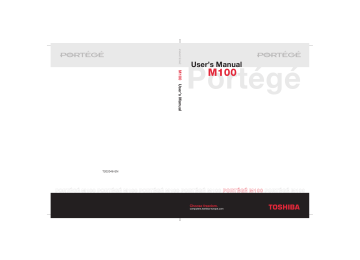advertisement

Portégé M100
Version
1
Last Saved on 25/06/2003 14:16
Power and Power-Up Modes
Power indicator
Check the Power indicator to determine the power status.
Green
Blinking orange
No light
Indicates power is being supplied to the computer and the computer is turned on.
Indicates the power was turned off while the computer was in Resume mode. The indicator turns on for one second and turns off for two seconds.
Under any other conditions, the indicator does not light.
Battery types
The computer has three types of batteries:
■ Battery packs – main and secondary (option)
■ Real Time Clock (RTC) battery
Main battery
When the AC adaptor is not connected, the computer’s main power source is a removable lithium ion battery pack, also referred to in this manual as the main battery. You can purchase additional battery packs for extended use of the computer away from an AC power source.
Before you remove the battery pack, set the computer to Hibernation mode or save your data and shut down the computer. Do not change the battery pack while the AC adaptor is connected.
The battery pack is a lithium ion battery, which can explode if not properly replaced, used, handled or disposed of. Dispose of the battery as required by local ordinances or regulations. Use only batteries recommended by
TOSHIBA as replacements.
Do not remove the battery pack while the computer is in Standby mode.
Data is stored in RAM, so if the computer loses power it will be lost. When the computer is powered off in Standby mode, and the AC adaptor is not connected, the main battery pack and optional secondary battery pack supply power to maintain data and program in memory. If the battery pack(s) is completely discharged, Standby mode does not function and the computer loses all data in memory.
Portégé M100
ENGLISH using Euro_M.dot –– Printed on 25/06/2003 as IM_M10EN
6-4
advertisement
Related manuals
advertisement
Table of contents
- 55 Equipment checklist
- 55 Features
- 55 Special features
- 55 Utilities
- 55 Options
- 56 Front with the display closed
- 56 Left side
- 56 Right side
- 56 Back side
- 56 Underside
- 56 Front with the display open
- 56 Indicators
- 56 AC adaptor
- 56 Slim SelectBay modules
- 56 DVD-ROM drive
- 56 CD-RW/DVD-ROM drive (optional)
- 56 Secondary battery pack
- 56 Slim SelectBay HDD adaptor
- 81 Setting up your work space
- 81 General conditions
- 81 Placement of computer
- 81 Seating and posture
- 81 Lighting
- 81 Work habits
- 81 Opening the display
- 81 Connecting the AC adaptor
- 81 Turning on the power
- 81 Startup time
- 81 Turning off the power
- 81 Shut Down mode (Boot mode)
- 81 Hibernation mode
- 81 Standby mode
- 81 Restarting the computer
- 81 Restoring the preinstalled software
- 81 Restoring the complete system
- 81 Restoring TOSHIBA utilities and drivers
- 82 Using AccuPoint II
- 82 AccuPoint II precautions
- 82 Replacing the cap
- 82 Changing Slim SelectBay modules
- 82 Removing a module
- 82 Installing a module
- 82 Using optical media drives
- 82 Loading discs
- 82 Removing discs
- 82 Writing CDs on CD-RW/DVD-ROM drive
- 82 Before writing or rewriting
- 82 When writing or rewriting
- 82 Data Verification
- 82 Media care
- 82 CD/DVDs
- 82 Diskettes
- 82 Using the USB diskette drive (optional)
- 82 Connecting the USB diskette drive
- 82 Disconnecting the USB diskette drive
- 82 Diskette care
- 103 Wireless LAN
- 103 Limitation of Liability
- 103 Usage Restrictions
- 103 Wireless LAN
- 103 Security
- 103 Wireless communication switch
- 103 Wireless communication Indicator
- 103 LAN cable types
- 103 Connecting the LAN cable
- 103 Disconnecting the LAN cable
- 103 Using the microphone
- 103 Using the internal modem
- 103 Region selection
- 103 Properties menu
- 103 Connecting
- 103 Disconnecting
- 103 Cleaning the computer
- 103 Moving the computer
- 103 Heat dispersal
- 104 Typewriter keys
- 104 F1 … F12 function keys
- 104 Soft Keys: Alt Gr Key Combinations
- 104 The Euro symbol
- 104 Soft keys: Fn key combinations
- 104 Emulating keys on enhanced keyboard
- 104 Hotkeys
- 104 Fn Sticky key
- 104 Windows special keys
- 104 Keypad overlay
- 104 Turning on the overlays
- 104 Arrow mode
- 104 Numeric mode
- 104 Temporarily using normal keyboard (overlay on)
- 104 Temporarily using overlay (overlay off)
- 104 Temporarily changing modes
- 104 Generating ASCII characters
- 110 Power conditions
- 110 Power indicators
- 110 Battery indicator
- 110 DC IN 15V indicator
- 110 Power indicator
- 110 Battery types
- 110 Main battery
- 110 Secondary battery (option)
- 110 Real Time Clock battery
- 110 Care and use of the battery pack
- 110 Safety precautions
- 110 Charging the batteries
- 110 Monitoring battery capacity
- 110 Maximising battery operating time
- 110 Retaining data with power off
- 110 Extending battery life
- 110 Replacing the battery pack
- 110 Removing the battery pack
- 110 Installing the battery pack
- 110 TOSHIBA Password Utility
- 110 User password
- 110 Supervisor password
- 110 Starting the computer by password
- 110 Power-up modes
- 110 Windows utilities
- 110 Hot keys
- 110 Panel power off
- 110 System Auto Off
- 111 HW Setup
- 111 Accessing HW Setup
- 111 HW Setup window